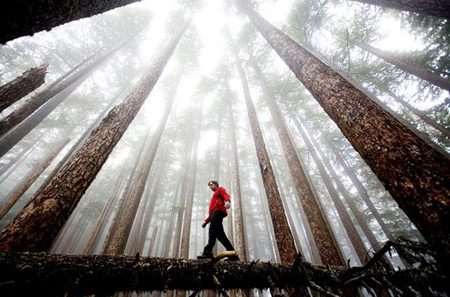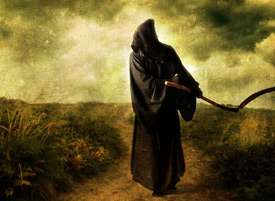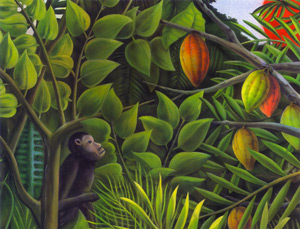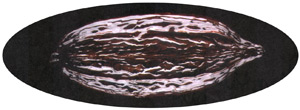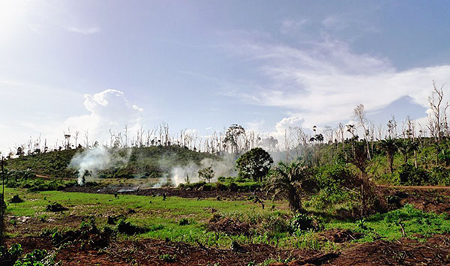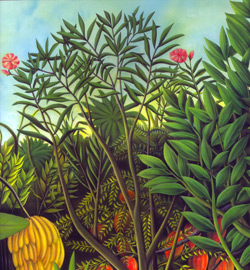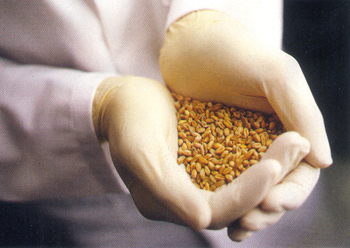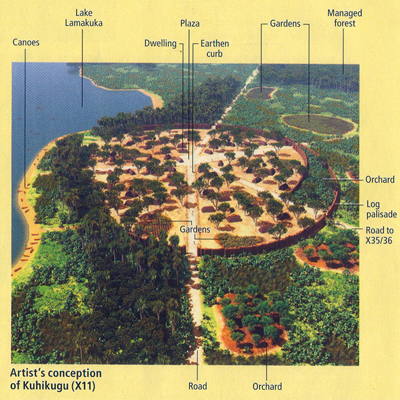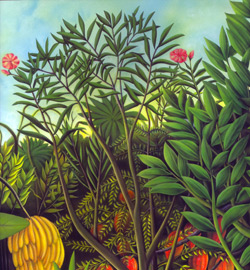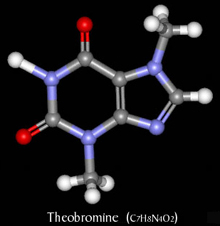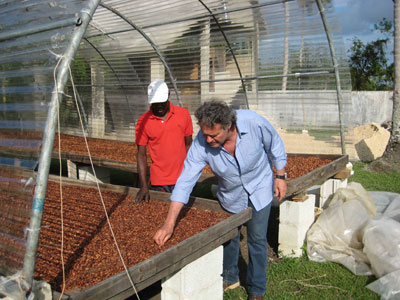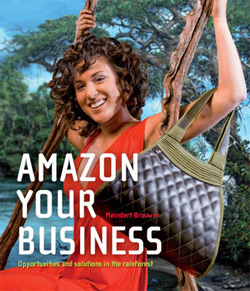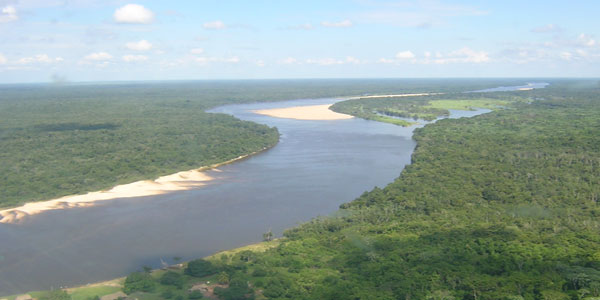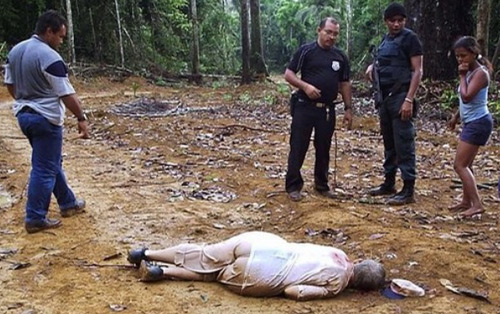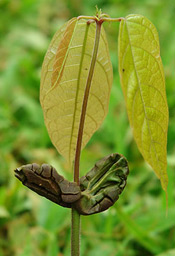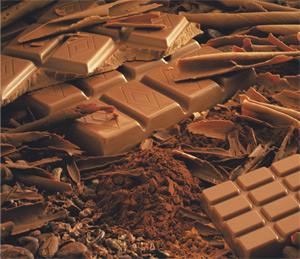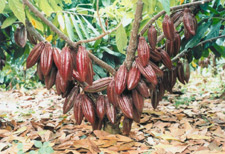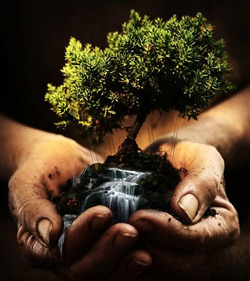We’re all travelers in the wilderness of this world, & the best we can find in our travels is an honest friend – Robert Louis Stevenson
Many have seized upon Chris Bright’s 2001 article for World Watch in search of strategies / tactics using Theobroma cacao, the tree from which chocolate derives, to save the rainforest. Specifically his prescriptive of the Brazilian cabruca movement to revive the Mata Atlântica (Brazil’s Atlantic Coast Forest) wiped out by decades of over-production, clear cutting, erosion &, some suspect, bio-terrorism (diseases intentionally set loose over a territorial dispute).
Much of this essay borrows freely & directly from him while diverging in updating the case, as well as distilling many concepts originally written elsewhere on this site. A compilation, so to speak, of the C-spot’s™ “greatest hits”, offering a more panoramic view on the subject… for 10 years on & we’re still having difficulty seeing the forest for the trees.
Every year more than 1,000 sq miles disappear from the Amazon Rainforest alone.
It faces increasing pressures, impinged upon from all sides for fleeting profit. Clear-cutting at the hands of loggers’ chain saws (often to build coffins for developed countries that end up buried); mining & drilling rigs (some of them illegal); soy bean farming; & cattle grazing (for steak dinners). Estimates run that at current rates of destruction, the Amazon will be chopped off the face of the Earth in a matter of decades.Chopping down the rainforest for timber, then letting cows graze the cleared land, presently has greater perceived value than leaving it intact. When calculated “under current development models”, concedes Chief Almir of Brazil’s Surui people, “a standing forest is worth less than its extractable parts”. Other tropical forests around the equatorial belt suffer a similar fate.
Lost along with these natural resources is perhaps the most vital resource of all: people living in the woods being displaced or dying off. With each passing, humanity loses eons of irreplaceable knowledge on the forests & its hidden treasures embodied in these various shamans, elders & forest dwellers – the equivalent of burning down whole libraries.
Eradication of the Amazon, & more broadly rainforests across the globe, is, in all likelihood, inevitable. Forest dwellers are a vanishing breed as their young continue to shun traditional ways for the lure of urban confines, resulting in a brain drain due to migration. Those who remain, especially leaders, are targeted by commercial interests for elimination (re: murder) as a barrier to development. Landowners are often too opportunistic, & campesinos (peasants-turned-poachers) too poor to be moral about any romantic notion of ‘saving the rainforest’.
The mission may be noble, yet only glimmers of hope remain.
Chocolate: Rainforest Ambassador to the U.N.
The promise of chocolate resides in the planet itself. Cacáo holds out the prospect of a strategic tool for conservation to ensure bio-diversity on Earth because wherever there’s cacáo, there’s water; & wherever there’s water, there’s life for it is life. So much so that Don Beto, ah k’in (or godfather) of the Ch’orti’ Maya in Quetzaltepeque Guatemala says that cacáo mirrors environmental health.
As a thirsty plant, cacáo draws water from the air; fixes nitrogen to help balance soil pH / acidity. Its heavy soil-building leaf litter serves as a break against erosion, naturally fertilizes, & attracts midges (its main pollinator) plus other insects, which in turn promote wildlife.
Cacáo’s shade tolerance as an understory tree places a rather low nutrient demand on its surroundings (at least for forest levels of production) that ironically contributes to protecting the forest canopy above as much as the other way around. Why? Well, added together, cacáo makes a great playmate for just about all flora & fauna, & a valuable ally of the forest. Whatever fruit, nut, tuber, hardwoods… you name it… practically all get along well with cacáo. And its very star-power — as a long-standing global phenomenon — attracts attention to the entire rainforest cast.In terms of diversity, cacáo already constitutes a microcosm of its own. Contrary to the popular imagination labeling all cacáo in the Amazon a single type called ‘Forastero’ (Spanish for, strangely, ‘foreign’), Amazonian cacáo is neither singular nor alien. Just the opposite: diverse & native on a staggering scale (its birthplace, after all, is the Amazon), a storehouse of all the variety in the species. All in keeping with expectations that the source of a plant’s origin coincides with the point of its greatest genetic diversity.
Moreover, Theobroma cacao is a lead-tree… a plant with near-universal appeal beloved around the world. Chocolate can be that symbol, an ambassador really, of rainforest preservation & restoration. This wouldn’t work with the rubber plant, mahogany or even banana trees – good as they are. Nor the soy bean & cattle under the Amazon’s future guises. For almost all of us have a personal relationship with chocolate imprinted in our memories from very early on in childhood.
What better way to bring everyone in on the cause, to become stakeholders in their own right, in light of the quip that 9 out of 10 people love chocolate… & the 10th is mistrusted for lying.
Tapping a Vein & Striking a Nerve: Right to the Heart of the Matter
Forest-friendly chocolate for forest-friendly consumers, Chris Bright noted, are out there dying to meet one another; each wanting to purchase a connection to a way of life, to an ideal, to a place, & a big issue. Grasping this from a human perspective seems within reach… if a bit of a stretch.
British Army Capt. Ed Stafford personifies this connection. Stafford stepped off from Camana, Peru, on April 2, 2008, & ended up at Maruda Beach, Brazil… 859 days later. He walked, swam & paddled the entire distance (4,000+ miles). Along the way he met Peruvian forestry worker Gadiel “Cho” Sanchez Rivera. Sanchez intended only to guide Stafford for 5 days thru a dangerous trek near Satipo, Peru, but stayed on it to the end of the expedition! Their epic makes them among the first on record to traverse the entire length of the Amazon River, from source-to-sea, unaided by motor transport. (In all fairness, probably some ancient or recent Amazon resident(s) covered the same trail before, unless everyone who lives there has enough commonsense to realize that walking alongside the Rio Amazon makes about as much nonsense as dragging a boat across the Sahara.) In some ways this harkens back to March 1540 when Francisco de Orellana sailed from Quito (Ecuador) to the Atlantic in August 1542 (without GPS, laptop, internet or maps… just guts) in the ultimate Man vs. Wild journey.
Naturally, Stafford & Cho encountered pit vipers, anaconda, mosquitoes, scorpions, electric eels & people – some pretty fierce at that:
“At first it was terrifying but it’s changed in our eyes during the expedition & a place that was once mysterious & dangerous to us is now a place where we feel safe. We’ve never had more relaxed evenings than when we sit in the middle of the jungle alone around the campfire. It’s not a scary place for us now; it’s beautiful; we’ve fallen in love with it & it feels like home.”
Remarkably, it works both ways. That is, chocolate & its forest-mates “thinking big”, with a gaia-like intelligence of people they care about & who care about them. Stevenson’s ‘honest friend’.
Overly anthropomorphic?
Anyone involved in cacáo understands that these trees have personality handed down & inherited by their chocolate. One reason humanity embraces it so fondly.
But in order for cacáo to be fashioned into a conservation tool of strategic importance, it first has to save itself.
It could use our help because cacáo finds itself under seige.
The adverse corollary to cacáo’s existence in its natural forest habitat makes it especially vulnerable to clear-cutting since it lives among the giants of the rainforest. As an understory tree relying on the canopy of the forest for shade cover, whenever the great timbers fall, cut up into floorboards, furniture wood or mulch, cacáo gets crushed on the downside.
On top of that, pruning cacáo pods in the rainforest is rarely the practice today, let alone the norm. To do so involves prohibitively difficult & nerve-wracking work in a jungle terrain that naturally slows down even the fastest who has to wander thru a slalom course from tree to tree that sparsely dot the forest floor in search of it amidst a jumble of other trees, climbing vines, & entangled creepers… not to mention fending off wild animals.
So comparatively precious little cacáo gets harvested in the rainforest. Most of it has been deracinated or uprooted from its birthplace, an orphan put on monoculture farms or mono-crop sun-plantations around the globe that turn it into a freak on steroids, a story especially well-told by Allen Young in The Chocolate Tree: A Natural History of Cacao.
This efficient solution trades the forest thriving with diverse flora for the relative safety & productivity of plantations. But just as plantations were a living hell for humans associated with slavery, it too exacts its costs with chocolate.
The Candy Monopsony: Sorry, Barbie, It’s No Board Game
For starters, millions upon millions of small-time, family farmers, most tending to less than 5 acres of cleared land, feed a world ever-hungry for cocoa beans. Highly fractured & disaggregated, calling them “loose-knit” exaggerates their ties. They toil mostly in isolation, far removed from the finished product that links up the long market chain of chocolate. With few exceptions, the cliché holds that farmers seldom taste what they grow… for them it’s solely a cash crop for export anyways. This produces a somewhat disinterested farm base of imperfect information, worst practices (Fermentation? Sun-dried beans? Time is money so forget it…) & usually dirt-poor commodity pricing. Considerations of land stewardship, soil management, varietal selection, proper storage, generalized agronomy… please, stop asking for too much. Hence, the ‘hodge-pod’ effect rampant throughout chocolate where even single-origins merge to decline in flavor & taste alike since every source pretty much grows the same hybrid mix. The downward curve worsens with under-investment & deferred costs.
Parallels to the pitiable tomato are hard to miss. Like chocolate, the tomato is technically a fruit, not a vegetable. In 1994 it became the first GMO (genetically engineered whole product) to hit the market. The target of disparaging remarks ever since, its flavor sank to such vapid levels of cardboard that it revived the market for heirloom varieties.
The big candy companies leverage this situation among small growers. Where the OPEC cartel forms an oil monopoly from the seller’s or supply side, Big Candy (ADM, Cargill, Callebaut, Nestlé’s, Petra, etc.) controls price from the buyer’s side; in effect, a monopsony. Any premium paid, whether via Fairtrade, direct trade, organic, bio-for-life, UTZ & a flood of other certifying bureaucracies, amounts to incremental income at the margins – the cream in the ganache for cocoa growers. The big game over volume & scale, however, plays out in centerfield with the candy giants, plus their hedge fund partners like Armajaro, at the dials of the scoreboard.
The established dynamic resembles Soviet-era Cuba or Poland: ‘you pretend to pay / we pretend to work’. Quality therefore suffers all the way around.
From the quality of life perspective for growers, incomes remain undervalued despite historically high levels on the world commodity markets (the bulk captured mainly by commodity traders); basic sanitation such as running water & sewage are substandard; inferior nutrition, medicine & education dashes any hopes for the next generation to seek a future in the ‘family business’.
Big Candy is in for its share. That it operates in treacherous territories fraught with political instability & labor unrest, spotty production yields & shoddy cocoa beans, poor infrastructure & dismal understanding of supply chain logistics – resulting in millions of tons of raw cocoa destroyed each season as inedible – means they have to play hardball while simultaneously appeasing their hosts with supplemental income by way of medical clinics, school buildings, low-interest housing loans & outright graft.
In between, the environment takes the hardest hit. In its headlong rush for efficiency, productivity & scale – to both spur & meet burgeoning demand – the industry unleashed a massive assault on the ecology that besets chocolate today. Rampant deforestation, soil depletion, then erosion, followed by dependence on hybrid seeds, petro-chemical fertilizers &, perhaps the worst nightmare of all, pesticides / herbicides to combat an army of diseases crippling crops everywhere with their colorful names (cocoa pod borer; witches broom; swollen shoot virus; black pod; vascular streak dieback). In the process, the candy giants have constructed a greenhouse-effect in which they too must live.
Direct sunlight on open plantations, cleared of the forest canopy cover, heats up exposed water – creating a Petri dish for viruses & bacteria. Then, monoculture trees lined-up neatly in congested rows make easy work for pests to wreak havoc by doing their damage. Nothing stops them in the way of a break or barrier from devouring one tree to the next. And when sun-drenched plantations succeed as they may thanks to hybridized clones, pesticides, herbicides, fungicides, et. al., they distort & warp the tree’s natural traits. Tropical biologist Allen Young noted how when Theobroma cacáo was “brought out of the forest & into the sun it grew to heights rarely seen in the dark undergrowth of the South American rain forest. And its fruits, the pods that produce cacao beans, swelled & ripened to magnificent melon-sized orbs”.
Growers cultivating the older heirloom cacáo meanwhile endure smaller harvests & up to 70% crop loss at the hands of diseases when sturdier more resistant clones, those referred to by Young, only lose, say, 50%. Correct, the dirty secret in the cacáo groves: far from immune, clones suffer devastating attacks too, despite rampant use of pesticides. But that 20% margin could spell the difference between economic survival & going out of business.
For all its prowess, the chocolate industry wakes up every morning from an anxiety-induced nightmare in knowing that after some 70+ years of research, expeditions, & lab experiments, it possesses but a couple defensive weapons (SCA 6, a cacáo strain discovered in Peru by FJ Pound back in 1938, and Guiana) to combat its most feared enemy – the dreaded witches broom disease. Hospital settings instruct how bacteria eventually adapt to antibiotics to spawn newer more resistant super-strains. The clock for cacáo is ticking. Before long, what happened to Henry Ford’s vision to transplant his assembly-line techniques on the rubber tree could very well repeat with cacáo.
(above) Regional Distribution of Major Cacáo Diseases; (below) The Nightmare Scenario: unless arrested, deadly diseases will spread to attack Big Candy’s vulnerability, detonating in the underbelly from where it sources 85% of its cocoa — Africa and Indonesia. Courtesy of CATIE in Turrialba, Costa RicaIn 1927, Ford incorporated more than 2.5 million acres, roughly the size of Tennessee, inside Brazil’s Amazon River Basin to cultivate Hevea brasiliensis – latex trees tapped to make rubber so Ford cars can run on tires… & complete the vertical integration of his auto empire.
Monoculture trees were planted by engineers instead of botanists in the same way Ford placed machines right next to each other back home in his Michigan factory. Nature ultimately rebelled. Neatly lined-up in congested rows of 200 trees per acre as opposed to about 7 in the Amazon’s natural ecology, they made easy work for pests to wreak havoc. Nothing stopped them in the way of a brake from totaling one tree to the next. By 1945 it all went flat, & with it a large tract of the rainforest turned into a mud hole after the tiny caterpillar ate them all.
Conversely, plants in their natural habitats deal with adversity in an ongoing drama of evolutionary adaptation that improves the breed & builds up resistance to predators in a gradual way thru a shared history. Pathogens in the wild form a symbiosis with their hosts to mimic the vaccine principle. Essentially, a bargain gets struck: “I let you infect me but don’t kill me”. One reason, for instance, why Criollo (among the most prized & high priced cacáos) survived quite well in the wild for centuries while under cultivation she reacts like an operatic prima donna; a sexual inbreed producing the fewest seeds & fluctuating yields evincing a delicate thin-skinned nature / fragile make-up – hence, susceptible to pestilence & shorter lifespan – all symptomatic of what’s clinically known as consanguine or inbred depression which can have disastrous effects in plants as much as in humans. (The collapse of the Hapsburg Empire due to incestuous intermarriage is just one illustrative example.) By contrast, inside the Lacandón / Petén forests around the Mexican/Guatemalan border abounding with ancient Mayan sites, Lopez in 1989 & Evans a decade later observed trees of low density, each in an isolated state relative to other cacáo trees, growing under forest shade. These are sub-spontaneous (semi-wild), belonging superficially to the Criollo family. They appear to be relics of traditional Mesoamerican cacáo & though small in size they seem to be doing quite well. Well enough to survive for generations, possibly centuries. These trees obviously possess inherent survival strategies, perhaps even to solve the riddle for the entire species.
Deforestation works against the organized-chaos of nature & against bio-diversity; causing erosion, infestation & over-cultivation to the point of exhaustion leading to an ecological wasteland. Stripped of protection from surrounding foliage, plant vigor deteriorates. Denuded of that buffer capacity, they turn vulnerable & ill suited to shocks. What’s left is depleted; a uniform crop lazily dependent on external inputs (those pesticides & petroleum-based fertilizers or, worse, the slash-&-burn method practiced in parts of West Africa).
The Look of Deforestation in Africa (photo by Jean-Claude Péclet)Agro-Wha???
An alternative for the deployment of quality cacáo & purity calls for integrated Agroforestry – agricultural technologies within forested settings – where it can thrive among a matrix of trees, plants, crops, shrubs (& even some proposed livestock). With the tallest for sunshade, & fruit bearing ones for bio-diversity, to build that buffer zone, it furnishes better protection against predators without having to resort to expensive chemicals aimed at thwarting them. A compromise between the jungle & the plantation, this ‘Garden-Forest’ approach asks growers to change practices, shifting from a model bent on volume & gyrating commodity prices towards one that places a premium on high quality & high reward. Added bonus: bio-diversity also buffers growers against price-shocks to any single crop.Marañón Canyon Cacao, directed by Dan Pearson, presents an example of this. It husbands chocolate seeds in an eco-sensitive manner, advantaged by a micro-climate located inside a horseshoe canyon up in the Peruvian highlands. There, a rare stand of reliquary trees grows, protected from many natural onslaughts that otherwise would plague them. That he experiences but a 10% crop loss (versus the 50% commercial standard) at the appetites of pest & insects can also be attributed to a couple other factors: inter-cropping & organic production.
Pests like the witches’ broom tend to be less of a problem in organic systems because, as explained, cacáo is less densely planted. As expected the harvest is also smaller. On the upside, the bottom line often increases. Without the use of expensive agrochemicals & the attendant damage in downstream costs to soils, waterways, & forest reserves, organic production costs are usually lower, so net profit may rise even when yield declines.
Attractive enough at any rate that the industrial giants who rely on bumper crops for the cheap abundance they supply to their chocolate-flavored candies are getting into this “green game” in a modified format. They’re betting on advanced sustainable agriculture coming to the rescue with miracle seeds, sprouting trees that speed-breed for high-yield, drought-tolerance & disease resistance. Howard Shapiro who has headed up plant science at Mars: “If we can treble the yield of cacao, farmers can tear up two-thirds of their lowest-yielding trees & use the land to grow fruit & timber”.
At least that’s the PSA.
A countervailing tendency in the business often states one position then enacts another. The experience of Ivory Coast during the 20th century bears scrutiny.
Once cocoa barren, Ivory Coast catapulted to the world’s #1 producer on the back the country’s independence movement in 1960. The Parti Democratique de Côte d’Ivoire – which had its roots in the Syndicat Africain Agricole – was led by a cocoa planter, Félix Houphouët-Boigny. He became the new nation’s first president. Revered as the ‘Sage of Africa’, he & his party favored a policy of extensive rather than intensive cacáo production. Instead of striving for massive yields per acre, Ivory Coast elected to clear more forestland for cultivation to achieve massive yields over ever more acres. The sage is now gone yet his legacy endures: in vaulting to the top spot of cocoa production, Ivory Coast has gotten both extensification AND intensification.
Will the reverse of the Ivory Coast model take root in the 21th century, namely, the old saw that the difference between ‘now’ & ‘then’ is that over there, back then, it was a ‘dog-eat-dog’ world, while in the here & now it’s the other way around? Looking at it from another industry, does anyone seriously believe if oil companies were allowed to drill more liberally on land (ANWR in Alaska, for instance), or offshore closer to land, they would refrain from deep sea drilling?
The Grand Dilemma
Whatever the industry track record, its proclamations & more importantly its methods point up to a wider & larger issue.
Agriculture across the globe currently absorbs nearly 70% of all freshwater, & 40% of the Earth’s land (& virtually all arable land). Rain-fed topographies alone simply don’t cut it. They fall short & are hardly enough when the crux of the matter projects by mid century that food production must increase 50% to meet rising population demands for a planet slated to reach 9.5 billion people — each destined to eat on average 35 tons in their lifetime. As is, humanity already consumes in total one-&-a-half planets. In other words, ‘unsustainable’.
Superfreakonomics, by Steve Levitt, puts the kibosh on PC speech codes that inveigh against anyone who dissents from conventionally-held views toward global warming, sustainability, cap-&-trade, Kyoto accords, etc., arguing that those approaches are counterproductive & expensive. Levitt’s solution: we have to invent our way thru.
The current suite of technologies includes: GMO – a sensitive topic for consumers; Maximized Yields – super seeds / speed breeding thru the aid of DNA markers; Artificial Environments – greenhouses, hydroponics, etc.; Agronomic management … GPS applied to IT – planting in the right places; Reduction in tillage to lessen soil erosion; Irrigation systems; Improved Machinery; Fertilizers & chemicals
This raises the specter that agribiz seeks to change the very definition of sustainability, away from a strict notion of ‘natural green’ in the conventional sense to one that incorporates meeting the burgeoning demand from future population growth. It’s a defensible & arguably legitimate position. Revolutions after all were fought over these basics. For all the talk in 1789 France about ‘egalite, fraternity, & liberty’, when push came to shove, then terror & blood, tensions rose & heated up with the price of bread. Or a half-century later in Ireland it boiled down to potatoes.
The dilemma pits organic vs. biotech, & consumption vs. productivity: either bring more acres into production & the environmental consequences that ensue, or increase the productivity & efficiency of current acreage. The latter redefines sustainability as the ability to produce more – much more – on the same, or better yet, less acreage.
Yum, the hand that feeds… roots of the new farmThe Amazon: Gateway to… The Amazon
If Henry Ford’s teachable-experiment in the Amazon ruins many a sleepless night for chocolate insiders, the report by one of their peers, Dr. Juan Carlos Motamayor – a principle responsible for mapping the cacáo genome – should equally alarm them.
Cacáo, especially of certain varieties, turns out to be an endangered species, according to Motamayor. In the last decade, geneticists & botanists have spotted rare types of cacáo in the Amazon Rainforest never before seen. Upon further investigation, a second trip to the forest laid bare, sadly, that the area had been chopped down, cleared to make way for cattle ranching & soybean farming.
Prior to his assassination, RFK wondered how many yet-to-be-written great American novels were lost in the imaginations of GIs killed in Vietnam.
Similarly, what are we losing in the way of potential cures for whatever ails cacáo, in addition to undiscovered treasures of flavor, by destroying the very storehouse repository for the entire species’ germplasm, the place it knows best to call home? Short of stopping deforestation, let’s at least study & tap the Amazon’s resources… before they’re all gone. This alone might simultaneously redress chocolate’s woes, & those of the forest.
Where all this zigzagging to rival a trek thru the Amazon leaves & leads us is back to the original question – Can Chocolate Save The Rainforest (& vice-versa)?
In addition to Marañón Canyon Cacao suggesting yes, more real-time concrete-evidence may hold the keys to the future, in conjunction with other novel (& not-so-novel) approaches.
The outlook for genuine sustainability finds hope in the groundbreaking work of Michael J. Heckenberger. If what he surmises is in fact true, then we’ve already done this, we meaning our human ancestors.
All the pure pristine nature subsumed under the heading ‘The Amazon’, inhabited by small “Stone Age tribes” & “primordial wildlife” that continues to grip our collective imagination – fantasized in a Rolling Stone article of an existence “unchanged since the dawn of time” – turns out to be largely secondary forest overgrown on a civilization that lived there for at least 1,500 years.
Heckenberger has lived & regularly visits among the Kuikuro indigenistas of Brazil’s Xingu Reserve to unveil this terra incognito hidden under the forest canopy. In a rarity for the modern age, the Kuikuro have retained the full breadth of their culture – language, rituals, arts, & economy. His book, Amazonia 1492: Pristine Forest or Cultural Parkland reads as a sequel to Charles C. Mann’s 1491: New Revelations of the Americas before Columbus. He shows that the ways of the Kuikuro, their organized settlements, gardens, fields, & orchards create a rich biodiversity using soil-enrichment techniques, long crop rotation cycles & a generalized forest management that form a direct link back to their ancestors. Evidence of ancient earthworks tells their story, & how humans helped shape the rain forest by design.
Kuhikugu, the largest pre-Columbian settlement yet uncovered in the Amazon, served as the hub of a radial trade network interconnected by carefully aligned roads the width of modern freeways, transecting the jungle with raised causeways or overpasses, bridges & canals. In precise plots they reworked the terrain, digging a vast irrigation system, growing manioc, harvesting pequi fruit trees, & collecting sapé grass to build their thatch houses. These societies practiced controlled burning of vegetative cover for soil enrichment, composting & recycling. Artificial ponds & weirs in the wetlands point to fish farming. Outside the main population zones, the ancients foraged into the deep forest for animals, medicinal plants & spirit worship.
The size of each village palisade, & the sum of these population clusters, integrated close together into larger political units numbering 30,000 to 50,000, totaled perhaps as many as 10 million in all. That compares to maybe 200,000 who inhabit the Amazon today. Theirs represent one model of land-use – a proto green-urbanism – ripe with advanced techniques for sustainable Agro-forestry.
Just as humans can destroy tropical forests, the Kuikuro prove we can also enhance them thru intelligent design. They could be instructive in the 21st century & beyond in how we mold & redevelop transitional rainforests.
Enter Bio-Prospecting
Leslie Taylor, founder of The Raintree Group, stands passionate in her support of the forest after recognizing the help it provided during her cancer treatment. Drugs derived from the rainforest plant periwinkle dramatically increased the chances for children with leukemia from a near certain death sentence to an 80% survival rate. Sadly, it’s now extinct in the wild due to shrinking forests. She asks “What if we had failed to discover this one important plant among millions before human activities led to its extinction?”
How many more of our young would’ve paid the price with their lives?
Several prescription drugs come from plant-derived sources. A quarter of all pharmaceuticals have roots in the rainforest. Yet less than 1% of tropical trees & plants have ever been studied by scientists.
Also consider that much of the world’s diet originated in tropical rainforests. Its bounty has gifted us with innumerable fruits: avocados, coconuts, figs, oranges, lemons, grapefruit, bananas, guavas, pineapples, mangos & tomatoes; countless vegetables… plus corn, potatoes, rice, squash & yams; spices galore starting with black pepper, cayenne, cinnamon, cloves, ginger, sugar cane, tumeric, vanilla. Nuts too, including Brazil nuts & cashews. And, of course, cacáo for chocolate. What would the world be without it? Incredibly, 3,000+ different fruits grow in the rainforests. Of these, maybe 200 appear on tables in the “First-World”. Compare that to Amerind forest-dwellers who eat over 2,000.The perceived value in chopping down the rainforest for timber, cattle grazing & soy beans farming pales next to the combined real + intangible economics from medicinal plants, fruits, nuts, oils & other resources like rubber, chicle & cacáo harvested sustainably. They have higher net worth in combined current asset value AND long-term income streams… year-after-year for generations to come, while still protecting the forest. Added bonus: wild-harvesting generates wealth creation for forest peoples rather than speculators or settlers. Not to mention the Amazon earned its moniker – ‘Lungs of the Planet’ – because it continuously recycles carbon dioxide into oxygen, producing some 20% of all oxygen on Earth, a huge global dividend.
Managed properly, as in centuries past with the Kuikuro, the rainforest can provide the world’s need for these natural resources on a perpetual basis in a similar dynamic to living off the interest while maintaining the principle in a savings account. A winning trifecta – financially, environmentally & morally.
A movement is now afoot that could dramatically alter its future.
Bioprospecting envisions a new pharmacological industry that draws together an unlikely confederacy: government technocrats & environmental conservationists; nutritional supplement manufacturers & venture capitalists; AIDS & cancer researchers with botanists & anthropologists; drug company executives & native shamans. They’re part of a radical experiment to preserve the rainforests by showing how much more valuable they are standing up… rather than cut down – a folly, Edward O. Wilson warns, that our descendants are least likely to forgive.
Cacáo could be but one beneficiary.
From Super Seed, Super Tree, Super Food to… Pharmaceutical-grade chocolate?
Manifold health claims emerging for cacáo could shift its sales appeal, at least partially, from a sweet sensation to nutriceutrical ‘superfood’. Raw-foodists already market it in this manner.
Its universal draw may be simple chemistry; a myriad of compounds (751 & counting) that fit & lock onto receptors in the human body tighter than pieces in a jigsaw-puzzle. Chocolate causes none of the anxiety & insomniac jitters of caffeinated coffee; yet its theobromine (C7H8N4O2) keeps the mind sharp & focused; lends itself to physical stamina; & conversation flows. Heck, chemists might want to add an honorary element – Theobromium – to the Periodic Table in celebration of its rank, assigning it an atomic number of immeasurable weight. Modern research attests to chocolate’s health benefits: lower blood pressure, improved cardio (generates nitric-oxide), better HDL (“good cholesterol”) plus one of the higher anti-oxidant ORAC ratings (a slippery concept but a simple handle nonetheless) of any known substance on Earth thanks to a host of polyphenols – catechin, epicatechin, quercetin & reservatrol among them. (Gram-for-gram, second only to spices but who consumes enough cinnamon to match favorably with chocolate on this score?) Throw in trace amounts of minerals (magnesium, potassium, calcium, & copper… perfect PMS food) & aphrodisiacs (PEA, serotonin, anandamide… then again, Europeans once regarded the humble potato, a staple endemic to Andean cultures in South America, an aphrodisiac too, probably because it was eaten by ‘uncivilized fornicators’; so by comparison, yes, chocolate must definitely be an aphrodisiac) & it’s a veritable pharmaceutical cocktail, probably even the world’s best anti-depressant (in other words, at least as effective as any other placebo). In a panegyric to it, Castro de Torres penned in 1640:To death & time, I challenge / And to both I make a bet / That no one in the world / Would kill themselves / Once they’ve had chocolate
Retro-rEvolution
Chocolate’s ‘green’ future in terms of a sustainable cash crop has already taken root in its recent past – hence the C-spot™ moniker ‘the retro-evolution of cacáo’. In isolated pockets & niches, boutique growers, bar-smiths & vendors have set up operations:
Claudio Corallo’s orchard, husbanding a humble &, until now, neglected varietal of potentially historical value: a possible direct descendent of the 1st cacáo to leave its American homeland in 1822 for the Old World… to San Principe Island off the Atlantic coast of Africa. An Amelonado rechristened Monka, grown on his own estate – Plantacao de Terreiro Velho. Corallo intimately knows the DNA of his trees & their seeds which goes with the territory when cultivating, harvesting, & handling every step in the processing chain himself (among the few who can make this claim). Beyond Bean-to-Bar, it’s Bud-to-Bud™ (cacáo flower bud to your taste-bud) & he a full-fledged ‘Budsman’.
Similarly, Danielo Vestri masters the craft at his Alegre Estate on Bonao, Dominican Republic. Ditto Diego Badaró of a fabled clan written about in Jorge Amado’s Violent Land — a turn-of-the century family feud that fertilized the cacáo fields in their blood. His Amma Chocolate label in Bahi, Brazil along an important stretch of the once-devastated Mata Atlântica, now brings recovery & rejuvenation.
Doing it all / doing it right: bar-smith Danielo Vestri going bud-to-bud™ (cacáo bud to taste bud) at his estate in Bonao, Domincan RepublicOthers have geared up to join the ranks:
Seneca Klassen with Kokoleka O’Ka Aina, an orchard that integrates the bounty of Hawaiian agriculture – including cacáo – to take back the tableland in central Wahiawa Valley of Oahu from Dole’s sugar / pineapple plantations & turn it into a showcase for agritourism;
Francois Pralus on Nosy Bé, Madagascar – home to his oft-stellar Le 100
Dan & Jael Rattigan of French Broad Chocolates in North Carolina reviving an abandoned cacáo grove in Costa Rica…
Add to these the growing list of in-country plays, or indigenous cacáo, planted, produced, processed & packaged in their home territory: Kallari, Cacaoyere (both Ecuador), Madécasse (Madagascar) & the grand-monarch of them all, El Rey (Venezuela).
Many are intersticial – that space between – projecting Euro preference & pricing juxtaposed with a nod to indigenous cacáo groves & history, often in countries whose current economy can barely afford either.
As such, their enterprises stand in the vanguard, some after just a couple years in operation, of a movement: a quasi-vintner model vertically integrating every step in the production chain in one spot, thereby keeping value-added profits close to home, in the pockets of people whose work is most responsible for bringing it to fruition. They take their lead from those social entrepreneurs, that gaggle of conscientious Christians in chocolate, who blazed the trail… from the Quakers, to the Amish & the Basel missionaries.
This goes some distance in helping revive those cacáo trees, some perhaps heirloom relics, that are largely abandoned or in decline, a few in areas of deeply rooted & rather sacred chocolate lore. Enough for Carlos Eichenberger of Danta Chocolate in Guatemala, feeling the weight of such a legacy in the very heart of Mayan civilization, to name his company after their great pyramid at Le Mirador.
All ramify into a wider crusade expanded upon by Meindert Brouwer in Amazon Your Business. Besides the double-entendre & the chica-chic cover, Brouwer’s book takes a swipe at those just minding their own business in a plea to make sustainability everyone’s business, seeing how only one Earth has yet been discovered so it pays to care for it.Surprisingly unabashed about ‘exploitation of resources’… the only caveat, just the right kind: namely, Analog Forestry, a variant of Agro-forestry. An integration of environment, enterprise & social endeavors, it combines hi-tech research & traditional methods to hasten forest succession. It achieves its aims of eco-restoration & bio-diversity by replanting scarred areas or reseeding exploited ones with carefully selected trees & plants which mirror the forest’s natural architecture & performance in order to blend in & replicate what was originally there.
Based on true renewables, shared benefits among genuine shareholders, ethics / respect for every logistical step & person at the beginning of the supply chain – including cultures, environments, costs & timing, the last in recognition that Mother Nature’s watch differs from a 24/7 punch clock. It’s about Community Trade fka ‘trade, not aid’; bottom-up with, granted, a generous helping-hand from NGOs, governments, corporations, universities, activists, technical assistants, & volunteers. And above all: qualia – that virtue defined by beautiful design, good taste & quality of life. Why above all? Because qualia more than any single marker in the contemporary universe positively shapes all other attributes.
The forest emporium touted in Amazon Your Business so far distributes more than 50 consumer goods such as body care, cosmetics, essential oils, perfumes (think Anita Roddick of Body Shop™ fame), caiman leather shoes, Treetap tote bags (featuring native rubber extraction), rings of Oro Verde (green gold — no mercury or cyanide — from Chocó Colombia, the first of their kind in the modern era m ined with hands ‘n pans & small shovels), medicines, energy drinks (guarana, açai, & the like), snacks, food supplements, furniture &, of course, chocolate. Specifically, from cacáo gathered by Volker Lehmann’s Rainforest Exquisite Products (REP).
An apt acronym, he reps both the forest people & forest produce in realizing a dramatic increase in the revenue captured for them by wild-harvesting a ‘savage’ fruit hand-gathered by several hundred collectors who roam & tread lightly over a vast area of the forest floor, pruning trees on chocolatales [literally ‘place where cacáo grows’], or elevated “cacáo islands”, set amidst the wetlands of Rio Bení, Bolivia.
These forest-economies could be the lynchpin to help decommodify cocoa to everyone’s benefit.
The current dirt-cheap price often converts to paying growers peanuts for it, which contributes to cycles of poverty in the producing world & mediocre chocolate.
Forest-economies offer cache (how many people can boast they wear, bath, or use goods from the jungle), exclusivity (only grows inside tropical rainforests with the bonus that any non-commercial value they add to these areas cannot be depreciated by production elsewhere), authenticity (the real deal), & natural ancient history (wildlife from centuries in the making).
So do they truly contain hopeful seeds for chocolate’s future? The problem with these examples: they lack capacity & perhaps scaleability which Big Candy demands. ‘F the environment’, candy giants think, ‘if we can’t sustain ourselves’. It would force the larger industry, premised on scale, to rethink its growth models. But just as sometimes it helps to slow down in order to speed up, the business may need to contract before it can expand & get it right. Ecclesiastes 1:15 instructs that which is made crooked cannot be made straight & what is lacking cannot be counted. In truth & fairness, Big Candy has taken significant steps to make right, & their good works abound, primarily through its coordinating body — the non-profit WCF (World Cocoa Foundation). And, yet, notwithstanding them, gateway prices & growers’ incomes remain depressingly low, land-use continues to deteriorate, & poor quality in the words of Mars researcher Ed Seguine equates with a 40% rejection rate of beans upon delivery. All of which prove the structural enormity of endemic woes.
Rio Bení, photo by Volker LehmannAhhh, So Divine… It’s To Die For (& some did)
Despite the promise & limited successes to date, the future appears unclear.
From a cold calculus, just how viable are these projects? Can they ever deliver to eventually stand on their own? Will they need a perennial hand-out from int’l funding agencies?
After all, though it sounds vogue & novel, individuals & think-tanks have been at this for quite awhile now. Ben & Jerry’s™ released Rainforest Crunch in 1988. For over at least half a century people have fought to preserve the Amazon against deforestation, against long odds, against shrinking returns, against time itself.
The last ran out prematurely for Sister Dot Stang. The ‘Angel of the Amazon’, she devoted her life & labor to protect the forest & alleviate poverty, wearing her trademark t-shirt emblazoned with “A Morte da floresta é o fim da nossa vida” (The death of the forest is the end of our life). It resulted in hers when a pair of gunmen murdered Dot in broad daylight on her way to a community council in 2005.She followed in the footsteps of Chico Mendes… rubber trapper… union organizer of the Xapuri Rural Workers in Brazil… no Marxist per se, just an eco-friend of the Earth. Along with co-activist Wilson Pinheiro, they instigated the counter-insurgency tactic of chaining people to trees to thwart loggers in the 1970s. Both met early death at the hands of murderous ranchers in the next decade.
According to the armed forces of avarice & expediency, another flea bites the dust. The body of Sister Dot Stang lies slain on the forest floor.That they & their followers walked a long trail of blood & treachery among cattle ranchers & timber loggers which began, from the European perspective, in the 17th century when Portuguese bandeirantes raided the rainforest to capture inhabitants for slavery, & yet the forest still stands… demonstrates cause for hope.
Broadened out into the wider scope, this mission acquires higher purpose. Chico Mendes discovered that what at first was a fight to save his workers’ rubber trees became a struggle to spare the Amazon rainforest, then ultimately “now I realize I’m fighting for humanity.”
Frankly, we could survive the loss of tropical rainforests girdled around the planet’s equatorial belt. The Earth won’t cave in on itself without them. Would we want to though? And can we afford to?
Sure we can. In a system that spends frivolously, we already do a lot worse than destroying the great woods of world.
The era of endemic unemployment might well benefit however from the jobs creation that planting, tending & harvesting trees offers, & in a way that develops sustainable goods & profits rather than uprooting them.
Or, moreover, what this means in our relationship to the planet & ourselves in solving a basic conundrum that very well could mire us, even bury us, in our own – vulgarity-spoiler – shit. Humans by nature are born breeders raised to be consumers who produce waste as by-product. As people are lifted from impoverished conditions & grow to support larger & healthier families, they in turn place greater demands on the environment thru development & expansion, leaving a larger footprint.
Unless, that is, we measure ourselves, take stock & heed before bullrushing into the next crisis.
In the modern age where deliberation becomes a dirty word, economic dynamics take on a breakneck warp; the restive mania & anxiety, the acceleration & stress of it all. No wonder meth labs sprout up in backyards, kids cheat on their exams, athletes pump ‘roids, & politicians / pundits habitually lie. For the love of money, honey. Money always talks / suckers still walk. And one can never have enough. Billionaires sense their own vulnerability just as the poor should the system collapse.
Raking in a pile or two requires two or three more. In the words of a Wall St. titan: ya never know what’s gonna happen… those who escaped Auschwitz paid their way out. They were then penniless but at least they were alive to live another day, takin’ their chances in places like America. Those who couldn’t were gassed & died.
Re-imagining our interpersonal & interplanetary relationships might just encourage a calm; could actually enhance our ability to solve problems from fiscal woes to medical care because a relaxed state of mind is conducive to clear thinking. And clarity is in dire supply at the moment & could be at an ever-higher premium should the era of The Great Wasteful-Abundance come to a close.
Peggy Noonan: “Parents now fear something has stopped. They think they lived through the great abundance, a time of historic growth in wealth & material enjoyment. They got it, & they enjoyed it, & their kids did, too: a lot of toys in that age, a lot of Xboxes & iPhones… But they look around, follow the political stories & debates, & deep down they think their children will live in a more limited country, that jobs won’t be made at a great enough pace, that taxes—too many people in the cart, not enough pulling it—will dishearten them, that the effects of 30 years of a low, sad culture will leave the whole country messed up. And then there is the world: nuts with nukes, etc.”
Handled wisely, this may only necessitate a change of course rather than an end to possibilities. Only the junkie, without help, refuses to change habits. Perhaps quantified as more ‘limited’, but genuine peace & prosperity can be liberating, which could be a small price for freedom that even Walmart™ shoppers could consider worth it. The costs of sacrificing a little now for something bigger & better later falls right in line with generations who went to their graves & left behind the thrift of their ways (including saving accounts) so the next generation could inherit a richer life. Ever since the Puritans, such delayed gratification of investing for the future rather than consuming in the present had been an American hallmark… until the Baby Boomers.
Financial markets learned the wrong lesson from the global meltdown of 2008. Far from banks & investment houses supposedly being ‘too big to fail’, they were too big to succeed except for those invested within a small circle. (Even certain CEOs within their ranks stood dumbfounded.) Same with chocolate. The current system of volume & growth has its benefits… for the few in control of it. An organizing principle infused with a new evolutionary spirit that opens & shortens the value chain for higher quality returns based on smart biology & estate-grade planting would enrich more at fewer people’s expense.
For cacáo, a hotspot crop if there ever is one… all the major cocoa-producing areas are so rich in biodiversity (South America’s Mata Atlantica & Amazon, Mesoamerican Bio-spheres, the West African Forests, the Malay-Indonesian archipelago, etc.)… its growers (‘Bromans’ in the C-spot™ vernacular), & chocolate appreciators the world over, this equates to quantifiably less in exchange for qualitatively more. To attain that right balance – the golden mean – between Agro-forestry & agribiz probably entails neither Kierkegaard’s ‘either/or’ but a mix of both: Nature’s Lab AND Man’s killer Apps.Envision well-plotted corridors within the forests &/or peripheral zones surrounding them, tapping their bounty as a repository for the seedlings, grafts & germplasm while growing the bulk of those crops, utilizing advanced research, right outside, on the edge of proximity, in the spirit of our ancient ancestors.
The rainforest then equals a preserve, the planet’s greatest archive of life on Earth with forest-dwellers being humanity’s ambassadors to the great outdoors whom we lose only at our own impoverishment. We should be accustomed to this for humans build libraries & museums to house & store everything from antiquities in the Met to plastic forks at the MOMA. In the example of Brazil’s Kuikuro, we’ve already done so; let’s just replicate it.
Chocolate-covered World: From Mayan Kingship to Urban Consumer (Sí, mi buen amigo, YOU)
For this model to work, consumers would then need to pitch in & do their fair share by contributing to pay for it & abandon the short-sighted purview computed by Oscar Wilde that we know “the price of everything, the value of nothing” – a pith borrowed for the title of Food First member Raj Patel’s book.
Shoppers by themselves won’t change the world but they play a role in shaping outcomes, whether it be GMO, traceability, nutrition, labor practices or the environment, becoming stakeholders in a dynamic the C-spot dubs ‘Bar-to-Bean’™.
One path to rainforest preservation calls for consumer markets of sustainable products that are louder & larger than today’s timber & agribiz lobbies; to incentivize all stake-holders to protect & husband humanity’s resources for long-term gains, rather than short-term windfall. A Facebook™ revolution of the pocketbook.
The Amazon holds clues that pre-Columbians were gardeners on a supreme scale. Just as the PC – the Bicycle of the Mind – revolutionized information & telecom, it points the way to modeling the future in other fields as well. If knowledge is power, then power decentralized into everyone’s laptop & palm device creates more & advanced levels of it (think Wiki). With bio & geo-engineering already manipulating elements on a planetary scale, we’re effectively all in the gardening business now.A simple choice really: either run roughshod with aggressive technology for dominion over the Earth perpetuating the current excess of mediocre product on-the-cheap, summed up as ‘everything we want – NOW’, or commune in sync with its natural forces & actively manage them to optimum stasis (true sustainability), realizing that more is not better, better is better. For chocolate that means select-grade cacáo that costs real money yet is far more prosperous on manifold levels because of it. The difference, say, between a brute Ultimate Fighter vs. an agile martial artist. Decapitas or Communitas? One continues a degrading downward spiral. The other could create a virtuous circle of winners: a healthier ecology fostering diversification & rainforest preservation, wealthier growers, & a better-informed citizenry everywhere.
If all this smacks of unrealistic idealism for an inordinately quaint subject which the media confects into the yumminy-delicious cupcake fodder for Food Channels & gourmet mag columns, & as something hard to get worked up over whose finished product has been so trivialized by sentimental advertising of simpering innocence, remember Blake’s ‘what is now proved was once imagined’.
Support from chocolate lovers everywhere is vital. Not as some pitiable charity donation atoning for past wrongs (a miserably failed dynamic). But as an investment to gradually build upon the work begun. Everyone should share an interest that we succeed together. A planet’s prospects & prosperity could well depend on it.
As alluded earlier, both the beauty & the bane of chocolate lay in its dislocation. Usually produced & harvested in one place, manufactured & consumed in another, creating often severe disparities in wealth, technology & cultural associations. These very weaknesses, however, can be flipped into strengths.
Chocolate just may be among the best vehicles for humanity to utilize the new communication technologies & build sorely needed social bridges because no other trading good on Earth possesses such near-universal appeal. The total effort required to deliver first-rate finished-chocolate involves a collaborative among people scattered all over the globe. When done right, it diminishes the empathy gap between us.
Think about it. About how even a small purchase helps alleviate misery &, more importantly, achieve the possibilities – guilt-free btw – with each & every bite you take, knowing that you’re heeding the bumper-sticker to ‘Save the Earth: It’s the Only Planet with Chocolate’.
